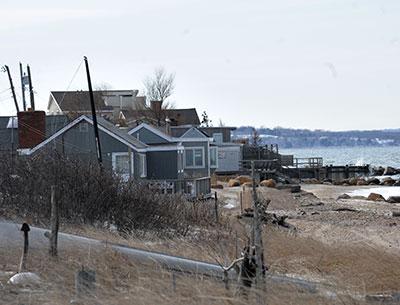House Move to Go to Zoning Board
House Move to Go to Zoning Board
Susan Knobel, who for more than a year has sought permission from the East Hampton Town Trustees to move her house from a severely eroded shoreline at Lazy Point in Amagansett, had reason to celebrate on Tuesday night. The trustees, who have debated the request while often asking for additional information, voted to authorize Ms. Knobel to apply for the variance relief that she will need from the East Hampton Town Zoning Board of Appeals to relocate her house to nearby lots that are at a higher elevation.
The lots in question are seaward of the coastal erosion hazard line, necessitating the Z.B.A.’s approval. Ms. Knobel will also need permission from the Suffolk County Department of Health for a septic system to be installed on the new lots. Should she receive the approvals, the trustees, who own and manage the land on behalf of the public, indicated that they would transfer her lease to the new lots.
The nine-member body has been divided over Ms. Knobel’s request, with Bill Taylor and Brian Byrnes, its newest members, most forcefully in support of the move. Others have expressed worry about the environmental impact of the move as well as the potential precedent set by their approval.
With six trustees present, the vote was unanimous, though Diane McNally, the trustees’ clerk, said that she was voting yes with great hesitation. “I honestly don’t know if you’re going to get a permit to put a septic system on that lot,” she told Ms. Knobel. “Part of me wants to ask you to move forward without us saying yes or no. . . . I’m getting the impression it’s not going to be feasible, from looking at the placement of the house and the septic on the lot.”
Brian Frank, the Planning Department’s chief environmental analyst, had given qualified support for the move last month. On Tuesday, Ms. Knobel reiterated Mr. Frank’s assertion that moving the house, removing its existing cesspool, and allowing its parcel to revert to a natural state would be a net benefit.
An engineer with the county’s Health Department, she said, told her that the proposed new septic system is far more environmentally friendly than the current cesspool, and its installation would require only small equipment, or could even be done by hand if necessary.
“I just want a chance to save my house,” Ms. Knobel told the trustees.

